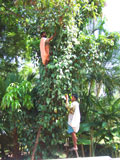April 2009 - The Malabar Pepper Company Interview.
Indispensable Pepper: Full Interview
Would you sprinkle sawdust over your delicious meal? That’s more or less what many people are doing by not paying attention to the quality of their pepper, says Ranjan Nambiar of the Malabar Pepper Company. Here, he offers some pointers on the spice that his family has grown for centuries and that has been a part of Indian cuisine and medicine for even longer. Since 2005, Elaioladon has been importing The Malabar Pepper Company’s Whole Black Pepper to the US from India.
How long has your family been growing pepper?
Eight hundred years probably. The first mention of the family is in 1200 AD, and pepper has been grown here forever.
What is it about the Tellicherry region of India that makes for the world’s best pepper?
This is where black pepper originated. It's a factor of terroir - a unique combination of climate, well-drained soils, slopes, and sun angle.
How do you capture your pepper’s unique aroma and taste?
Immediately after processing, the pepper is packaged on the farm in a nitrogen-sealed inert environment. This locks in all the essential oils that give our Tellicherry pepper its flavor. That flavor is revealed in the powerful aroma that you smell when you open one of our pepper packets.
How is this quality achieved?
Since the pepper is grown on the farm, we are able to monitor the green pepper's origin. This is not the case with most exporters, who buy their pepper from wholesalers on the open market and have no record of the pepper's origin nor control over the quality of the product. Other exporters try to exercise quality control in the final processing before packaging, but by then many of the oils have evaporated.
The Malabar Pepper Company doesn't use any pesticides. Is this the case with most pepper producers?
No, nor are exporters who reprocess pepper for export able to guarantee or control the growing or drying methods of the pepper they buy on the regional wholesale markets. Our pepper is grown according to organic methods. However, we categorize our pepper as "natural" rather than "organic" as certification for small producers is inordinately expensive in India due to a lack of local certification agencies. Small producers can rarely afford certification, which is done at expensive international labs. We do aim to achieve organic certification as soon as the costs become viable.
How important is pepper in Indian cuisine?
Indispensable. Chile peppers, which are now used with black pepper to create the spice in Indian cuisine, were imported from South America only as recently as the 16th century. Black pepper is a key ingredient for traditional ayurvedic medicinal preparations, unlike chile pepper, which is only used to add fire to dishes.
What are your favorite recipes that demand pepper?
Pepper and salt are indispensable at your table. I encourage people to sprinkle our freshly ground pepper over everyday dishes like eggs and steaks, rather than using pre-ground pepper. (A pepper grinder will do, but a mortar and pestle is good for more course pieces of pepper.) The difference is dramatic. You might as well use sawdust, as all the flavor has escaped in pre-ground pepper. A good trick for adding rich flavor to meat or vegetable stews is to fry coarsely-ground pepper in oil for 15 seconds before adding the other ingredients.
What is the risk of buying "any old pepper"?
All pepper that is sold in the US is imported and therefore subject to FDA import requirements. If it’s met legal requirements, imported pepper is technically safe for consumption. (One key concern is salmonella contamination, if pepper is not stored properly before export.) Our pepper is immediately packaged after processing and never placed in open storage, so it not only tastes fresher than any other pepper, but is also completely safe from contamination.
Your pepper is sold when it is black. What stages has it passed through before that?
Pepper at harvest is green in color when plucked from the pepper vine. The green peppercorns are stripped from the stems (or spikes) and blanched for about a minute in hot water. This hastens the chemical process that results from drying the pepper in sunlight and gives the black pepper its rich dark-black color.
What don’t most people know about pepper?
That, like the grape, it is a vine that relies on a unique terroir for its flavor. In other words, like a great wine, the place of origin is critical. But, unlike wine, which can come from a variety of exciting grape varieties and international terroirs, there is only one great black peppercorn, and it comes from the Tellicherry region.
return to newsletter menu
Don't forget the freshly ground pepper!

Ranjan Nambiar of the Malabar Pepper Company

Green peppercorns

The Malabar Pepper Company, in Kerala, lndia
